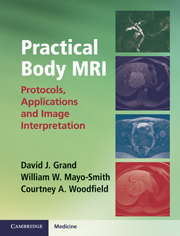Book contents
- Frontmatter
- Contents
- Preface
- To the reader
- Acknowledgments
- Glossary of terms andabbreviations used in Body MRI
- Section 1 Body MRI overview
- Section 2 Abdomen
- Chapter 2 Liver
- Chapter 3 Pancreas and biliary tree
- Chapter 4 Kidneys
- Chapter 5 Adrenal glands
- Chapter 6 MRI enterography
- Section 3 Pelvis
- Section 4 MRI angiography
- Index
- References
Chapter 5 - Adrenal glands
from Section 2 - Abdomen
Published online by Cambridge University Press: 05 November 2012
- Frontmatter
- Contents
- Preface
- To the reader
- Acknowledgments
- Glossary of terms andabbreviations used in Body MRI
- Section 1 Body MRI overview
- Section 2 Abdomen
- Chapter 2 Liver
- Chapter 3 Pancreas and biliary tree
- Chapter 4 Kidneys
- Chapter 5 Adrenal glands
- Chapter 6 MRI enterography
- Section 3 Pelvis
- Section 4 MRI angiography
- Index
- References
Summary
Adrenal MRI protocol
Indications
This protocol is most frequently used to characterize incidentally detected adrenal masses (incidentalomas) found on other imaging modalities.
Preparation
IV contrast agent: None used routinely. If radiologist chooses to administer contrast, use 1 mmol/kg gadopentetate dimeglumine at 2 cc/s
Oral contrast agent: None
At completion of exam, page radiologist to check if intravenous contrast is necessary
Give patient 2 L nasal oxygen
Continue axial single-shot fast-spin echo FS to level of bladder
Exam sequences
(1) Coronal T1 spoiled gradient echo BH – Anatomic overview. Assess for adrenal mass. Be certain that “adrenal” masses are really in the adrenal gland.
(2–3) Axial T1 in and out of phase (IP/OOP) – Assess for intracellular lipid (microscopic fat) within adrenal lesions. This is by far the most important sequence for the adrenal gland.
(4) Axial T2 single-shot fast-spin echo – Identify T2-bright lesions within the adrenal glands.
(5) Axial T2 single-shot fast-spin echo FS – Compare to prior sequence to identify macroscopic fat.
(6) Radiologist check for contrast. If contrast is to be used run:
(7) Volume-interpolated gradient echo BH pre.
(8) Volume-interpolated gradient echo BH post 20 seconds.
(9) Volume-interpolated gradient echo BH post 1 minute.
(10) Volume-interpolated gradient echo BH post 2 minutes.
- Type
- Chapter
- Information
- Practical Body MRIProtocols, Applications and Image Interpretation, pp. 58 - 63Publisher: Cambridge University PressPrint publication year: 2012



